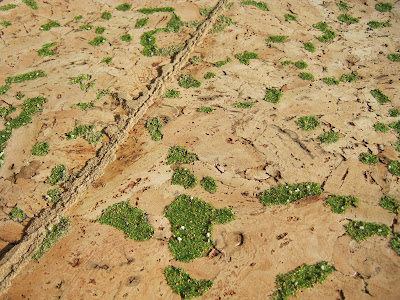For a long time I have been meaning to construct a decent tabletop for our games. The idea was to make a 12' by 6' table from textured cork wall tiles in 2' by 2' segments. This would do for any game in desert or semi-arid conditions, which means basically anywhere we place our ancients games apart from northern or western Europe. The table would also be scale neutral.
For a few years I have been using the annual Society of Ancients Battle Day game to concentrate my hobby efforts. I don't have a great amount of time available due to work and family commitments, so I want to make sure that anything I do gains maximum return. This gives me a timetable of sorts and a commitment to doing a certain amount of work. The first time around, it was Callinicum, which I was able to present with all of my own figs after painting up some Sasanians and Arabs. The second time it was Zama, so I took a couple of years to produce a large Republican Roman consular army from scratch, which I was then able to use for Magnesia. The game in the third year was Khadesh, and Simon at the club was able to do that all by himself, which gave me the time I needed to complete the Romans. The fourth time around (this year) it was Plataea, and apart from a few units of hoplites and some Persians, we already had all the figures between us, with some help from Donald at the Greenock club. This gave me some extra time, so I decided to go for it and produce my table top.
The pictures that follow give a sense of how the project developed. I decided to take them throughout so that I would have some sort of record of how it went.
I flocked some of the depressions on the tiles and then glued them onto cork backing to make them up to roughly 2' square pieces, disguising the join with sand. This didn't work too well, because the cork is relatively flexible, making it almost impossible to hide the joins. I was trying as far as possible to remove the grid-line effect common with terrain tiles, and it didn't work.
So I bought some 2' segments of hardboard and glued the tiles onto those, using plastic wood to seal the edges and to disguise the joins. As you can see from the shot above, this worked a bit better.
I then flocked around the joins to help them blend in a bit more. You can still see them, but at a gaming distance they look surprisingly effective. The joins between the 2' squares are of course still visible, but the overall effect is fine.
Plataea is pretty much a flat battlefield, with only one hill of note and a couple of muddy river courses. These were really easy to construct, because the cork is thin enough (6mm) to cut to shape. Some of our club players were particularly interested in this part, because it could be used to make trench systems for Tobruk or whatever.
Above, you can see the flocked tile with the stream section running from top to bottom.
I then painted the river bed brown and sprinkled on some sand. The kids loved to help with this bit...
The photo above shows the final product: PVA glue to create the water effect, and flocking to hide the joins between tiles.
Originally, I was hoping to represent Mount Cithaeron to the left rear of the Greek army, but I realised after some trial and error that it would take too much time and effort to get it right. It would have made a nice scenic piece, but it didn't play any part in the battle itself, so eventually I just used some steep hills I already had. Besides, this way I won't have to store it, and the idea was to make a tabletop that could be used repeatedly.
The finished tiles are not very thick, about 1cm in total, which will really help with the storage. They are also very robust because of the hardboard, which also makes them a bit heavy. That's probably a good thing because that way they won't warp so easily. I'll just store them in the loft when I'm not using them.
Carronade in May was a trial run, without the hardboard, but I was able to finish the field completely for Claymore at the start of August. I was quite surprised by the amount of positive commentary. The Greeks and Persians make for an impressive display, and the colours really stand out against the sandy effects of the cork tiles. Their relative brightness really helped with the overall look. I was asked a few times how I made the river sections, and quite a few people commented on how unusual it looked - the "desert" effect went down really well.
Now that I have them, I'll maybe only need to do a little bit of work to make a few more tiles for variety, depending on the battle. One thing we won't be doing, however, is Chalons, which is next year's Society game. We just don't have the figures for that one. Besides, I need a break...
Retrospective: Bermuda Triangle
-
Recently, I came across a couple of “news” stories about the Bermuda
Triangle, a topic I hadn’t thought about in years. Growing up in the 1970s,
however,...
1 hour ago

















.jpg)






















.jpg)







.jpeg)













.jpg)

















































































That looks really effective. Good work.
ReplyDeleteNicely done - I'm about to embark upon a terrain panel project of my own so your post was very helpful
ReplyDeleteMiles
The terrain looks simple but very effective, Paul!
ReplyDeleteCheers, Simon
Very well done!
ReplyDeleteThanks for looking, everyone!
ReplyDeletePaul
Very effective Paul.
ReplyDeleteVery nice! Seems to be impressive...
ReplyDeleteGreat looking board and clever choice of material!
ReplyDelete